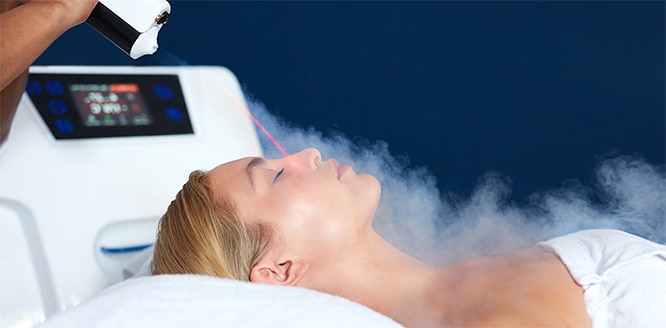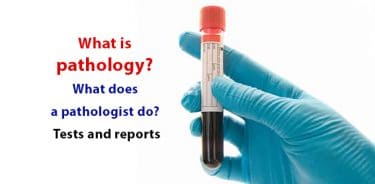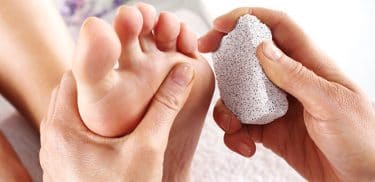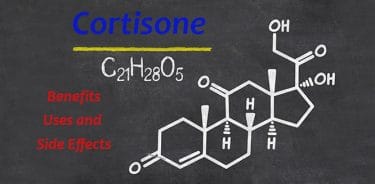Cryotherapy is a technique where the body is exposed to extremely cold air for a short period. It is literally means cold therapy and clears unhealthy tissues off by freezing them. It relieves inflammation and is good for the circulation. Cryotherapy can be performed either locally or on the whole body. Local cryotherapy focuses on the painful, edematous and injured body parts. It can be administered in a number of ways, including ice massage, coolant sprays, ice baths, etc. In whole-body cryotherapy, the person is exposed to cold in an enclosed chamber or a cabinet. It is used for the treatment of eczema, warts, calluses, sunspots, genital warts and some types of cancer. The method is easy to apply with immediate results. Side effects such as edema, pain, bleeding and infection may occur. It is not suggested for the people with hypertension, diabetes and heart disease.
Table of Contents
What is cryotherapy?
Cryotherapy is a method used to obtain medical benefits by lowering the body temperature at tissue and cell level. Gases such as liquid nitrogen are used. The therapy aims to repair the damaged cells in the body.
Local cryotherapy is used in cases of acute injury such as sprain, strain, inflammation, edema, pain, fever. Whole-body cryotherapy is used for chronic conditions or to relieve muscle pain and fatigue in athletes. (1)
Studies show that cryotherapy may be effective in many conditions, such as slowing down the aging of the skin, supporting fat burning, and preventing chronic diseases. The degree and duration of applied cold varies depending on the skin type and the problem; unattended and prolonged cryotherapy may be fatal.
What is cryotherapy used for?
Cryotherapy is a relatively new form of treatment; therefore, there is not much evidence for its benefits. On the other hand, there are many studies supporting the benefits.
Diseases in which cryotherapy is used:
Pain treatment
In local therapy, cooled air is applied to the target injured areas to relieve pain and edema. Cold air narrows the blood vessels, alleviates the inflammation and helps with pain management by regulating antioxidant balance. It may be helpful in migraine treatment as it relieves the nerves in the neck region.
Sports-related injuries
Cold air contributes to muscle recovery and muscle activity by relieving the irritated nerves. Therefore, it is commonly used in modern sports medicine. (2) Ice packs or cold sauna used for the injured or painful muscles accelerate the recovery by increasing the circulation. They also increase the energy capacity for exercising.
Anxiety and depression
Extremely cold air used in whole-body cryotherapy helps balance psychological tension. It may especially be used in the treatment of anxiety and depression. It promotes the release of adrenaline, noradrenaline and endorphin by leading to physiological and hormonal reactions.
Rheumatic diseases
Studies show that cryotherapy significantly relieves pain and increases mobility in rheumatic diseases such as arthritis, which causes chronic pain in joints and muscles. It also supports the treatment of frozen shoulder, a condition which limits shoulder mobility.
Low risk tumors
Targeted cryotherapy, called cryosurgery, is a technique used in the treatment of benign or malign lesions, especially some types of cancer such as prostate or kidney. It eliminates the cancer cells by freezing them. It may also be used in the treatment of many types of tumor. It is considered that while whole-body cryotherapy alleviates inflammation, it may also reduce the risk of cancer. (3)
Skin conditions
Cryotherapy stimulates the immune system by increasing antioxidant levels and initiates the body’s self-renewal process. It cures skin conditions such as eczema (dermatitis), warts and calluses by preventing water loss. In the cosmetics industry, it is used in anti-aging therapies to increase blood circulation, rejuvenate the skin and detoxify the body. (4)
It alleviates inflammations
When the immune system becomes overactive, chronic inflammation associated with health conditions such as multiple sclerosis, fibromyalgia, cancer, diabetes, depression, dementia and arthritis may develop.
Cryotherapy may alleviate inflammation by increasing anti-inflammatory protein levels and strengthen the immune system by reducing the risk of chronic diseases. It may also help protect heart health by balancing the blood pressure. (5)
It may help weight loss
Although there is not much evidence on the subject, some studies show that cryotherapy supports weight loss. Theoretically, it is thought that extremely cold air applied for a few minutes force the body to work harder to keep it warm, and this accelerates the metabolism.
Cryotherapy of genital warts
Liquid nitrogen is used to freeze warts in the treatment of genital warts with cryotherapy. Nitrogen creates water blisters around each wart and warts fall off as the blisters heal. The recovery period depends on the region and the number of frozen warts. Patient will usually recover within 1 to 3 weeks.
Cryotherapy is a fast and effective solution in the treatment of genital warts, but it is not usually used when genital warts spread. Multiple sessions are required to prevent the problem from recurring. After cryotherapy, pain, edema or a slight burning sensation may occur in the applied area. Most of these conditions are temporary. (6)
If you experience problems such as fever, bleeding, bad-smelling or yellowish discharge, or chronic pain after cryotherapy, contact your doctor immediately.
After genital warts treatment:
- A watery vaginal discharge may occur for about 1 to 3 weeks.
- Use sanitary pads instead of tampons for 2 to 3 weeks.
- Avoid sexual intercourse until the complete recovery.
- Don’t swim, don’t use public baths.
Men treated for genital warts on the penis, scrotum, or in urinary tract should avoid sexual intercourse until the treated area heals and the pain relieves. This recovery usually takes 1 to 3 weeks, depending on the size of the area treated.
Freezing of genital warts is an effective way to remove warts. However, it does not cure human papillomavirus (HPV) infection. The virus may remain in the body in an inactive state after warts are removed.
How is cryotherapy done?
Cold Sauna
It is the most popular form of cryotherapy.
- In this method, a patient is exposed to extreme cold for 2-3 minutes in a tubular cabinet that covers their entire body with his/her head out. (7)
- Nitrogen gas at -100 / -180 degrees Celcius is sprayed to the standing patient through the elevator system inside the cabinet.
The method is used to accelerate the metabolism, treat pain, improve treatment period and burn fat.
Cryo room or cold room therapy
- In this method, a patient stays for 2-4 minutes in an extremely cold room emitting liquid nitrogen vapor ranging from -110 / -160 ℃.
- The patient enters the room with his/her underwear and moves constantly according to the instructions given so that the blood circulation does not stop.
- Gloves, socks, slippers, thermal boots, face masks or earplugs should be provided to protect the hands, feet and the head.
- During the therapy, the body temperature decreases to very low levels in seconds, the brain thinks that the body is in danger and directs the blood to the problematic area and stores oxygen and nutrients in the damaged tissue.
- A strong immune system response occurs thanks to the congestion in vital organs through intense cooling; inflammation relieves and endorphin release increases.
Cryosurgery
- This method is a minimally invasive surgical procedure used to treat infection in organs or kill cancerous cells.
- With the help of special devices, liquid nitrogen or nitrogen gas derivatives between -80 / -190 degrees Celcius are applied to the damaged tissue to eliminate it.
- Gas that contacts the tissue freezes and eliminates the targeted tissue in a short period.
- These non-functional dead cells are replaced with new tissue.
Local cryotherapy
Cold gel packs, ice bags, ice massage, ice bath or cryotherapy devices are applied to the targeted areas of the body at intervals of 20-25 minutes per day, especially after physiotherapy or exercise. (8)
Cryotherapy should be carried out under strict supervision and should never be applied longer than recommended. Unattended and prolonged exposure to extreme cold may be life-threatening.
What to know before cryotherapy?
- In whole-body cryotherapy, wear socks and gloves to protect your hands and feet from freezing.
- Make sure your clothes are dry.
- If you have a piercing, remove it or cover it with a bandage.
If cryosurgery is to be performed, your doctor should inform you about the preparation.
What to do after cryotherapy?
- The care and hygiene of swelling and edema that may occur after cryotherapy is very important. Wash the treated area with soap and water 2-3 times a day or clean with povidone iodine solution. The scab will fall off by itself, but if it is adherent to the wound, an antibiotic ointment should be applied twice a day.
- Be sure to see your doctor for follow-up examination after 2-3 weeks.
- Wait for at least 2 weeks before a second session.
Where is cryotherapy done?
Prefer a dermatologist or specialist’s clinic or a licensed facility for cryotherapy procedures. Depending on the source of your problem, you may apply to general surgery, dermatology or obstetrics & gynecology outpatient clinics of hospitals.
How is cryotherapy performed at home?
The easiest way to perform cryotherapy at home is to apply an ice pack to the painful or edematous area periodically. You should not apply it more than 20 minutes. Apply the ice pack by wrapping it in a towel to avoid damaging your skin.
Advantage of cryotherapy
- It enables non-surgical treatment of some tumors and does not require anesthesia.
- Risk of complication is low.
- It is fast and easy to apply
- No change of routine after application is required.
How long does cryotherapy last?
Duration of cryotherapy varies according to the location, depth and size of the problem. The ideal time for each session is around 2 minutes. However, depending on the lesion, the procedure may need to be repeated several times.
While 5-6 sessions are required for the treatment of warts on the sole of the feet, 2-3 sessions may be sufficient for the genital areas. Some athletes apply cryotherapy twice a day. Others apply daily for 10 days and then once a month afterwards. Regular application for a month is recommended for cosmetic benefits.
How do blisters heal after cryotherapy?
As dead cells are eliminated after freezing the wound, water blisters are one of the common results of cryotherapy. With the use of the recommended ointments, tissues in the applied area fall off by themselves within 1-4 weeks. An antibiotic ointment is used for dressing.
When do warts fall off after cryotherapy?
In most of the cases, warts on the skin are harmless and usually go away without treatment. However, this may take years. Genital warts should be examined by a doctor.
One of the most common ways to clear warts off is cryotherapy. An average of 2-4 sessions can be performed at 2-3 week intervals. After the treatment, the applied area forms a scab and this dead tissue falls off in about a week. Sometimes, warts may recur after the treatment, and more than one method of treatments may be required.
Prices of Cryotherapy
Cryotherapy is a process that can be applied for many problems. The price is determined after the examination depending on different factors. The pricing policy of each healthcare facility is different, but an average 3 minute session is priced between 25 USD-70 USD.
Risks of Cryotherapy
- Whole body cryotherapy is generally considered safe. However, it may cause nerve damage and weaken lung functions in those with diabetes, hypertension, lung disease, allergies triggered by the common cold, limb neuropathy, and cardiovascular disorders.
- Liquid nitrogen vapor used in cryo rooms may reduce the amount of oxygen in the room and cause hypoxia (oxygen deficiency), which may cause the patient to lose his/her consciousness. In addition, temporary memory loss that lasts less than 24 hours and eye damage may occur.
- The most common side effects are pain, numbness, tingling, redness and skin irritation. These are usually temporary, but if they do not go away within 4-5 days, inform your doctor.
- Applied area may become lighter or darker in people with darker skin.




